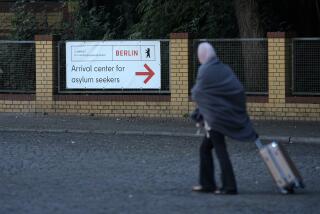Despite Doubts, Canada Accepts 152 Castaways From Sri Lanka
- Share via
ST. JOHN'S, Canada — Police officials Wednesday said they are investigating whether 152 Sri Lankan refugees pulled from lifeboats near the Newfoundland coast had come from West Germany and not directly from their homeland as part of a conspiracy to violate immigration laws.
However, in spite of the Royal Canadian Mounted Police investigation and reports from West Germany that the refugees had been living in a detention camp near Hamburg, Benoit Bouchard, minister of employment and immigration in Ottawa, announced that all 152 have been approved for refugee status, meaning that they can stay in Canada for at least a year and probably permanently.
The group, which includes three women and five small children, was picked up about six miles south of Newfoundland on Monday by Canadian fishing boats.
Leaders of the group said they are members of the minority Tamil ethnic group, which claims to be violently persecuted by the majority Sinhalese in Sri Lanka.
They told of an uncomfortable monthlong voyage from an assembly point in southern India, followed by a frightening five days in two overcrowded lifeboats without food and only a little water. Spokesmen for the Sri Lankans repeated their story Wednesday, saying they had been abandoned at sea by a ship they couldn’t identify.
Canadian police immediately cast doubt on the story, saying the healthy and dry condition of the Sri Lankans was inconsistent with five days in open boats on the rain-swept and foggy North Atlantic, let alone a month in the crowded and poor accommodations the refugees said they experienced on board the ship.
More doubts came Wednesday from West Germany, where various accounts held that the refugees had fled a detention center at Jork, taking buses to the French coast where they boarded a ship variously described as Lebanese or Chinese, which dropped them off to make their own way to Canada.
The Sri Lankans continued Wednesday to deny they had been in Germany. Nalliah Wijayanathan, a 46-year-old accountant, told a news conference that “we came from Sri Lanka” via India, denying that they had been in West Germany. “We need not lie,” he said.
Inspector Jack Lavers, director of the Royal Canadian Mounted Police unit here and the man who first said there were inconsistencies between the refugees’ story and the factual circumstances, acknowledged to reporters Wednesday that he had no evidence to disprove the group’s account.
“It is all in the area of conjecture,” Lavers said, adding that the refugees had not deviated seriously from their original claims.
In fact, in saying that the police were “looking into the possibility of a conspiracy to breach the Canadian Immigration Act,” Lavers indicated the targets were not the 152 refugees but groups in Canada or Germany that might have engineered the operation.
As it stands, where they came from and how they got to Canada is immaterial since they have been accepted as refugees under a policy that virtually guarantees the admission of Sri Lankans and prohibits deportation unless investigation proves they are subversives.
“The fact of (their possible presence in) Germany would only come into question if they had been accepted as refugees or given permanent residence status,” said Jerrett Letto, St. John’s director for the Ministry of Employment and Immigration.
“The fact that they were routed through Germany makes no difference,” he told a news conference.
In a later conversation with an American reporter, Letto said that “refugee status” is a specific legal designation and does not necessarily include even a long stay in another country.
Even if the Sir Lankans lied, he added, they won’t be sent back. “We don’t deport Sri Lankans.”
The most serious challenge to the refugees’ story came from a fellow Tamil who served as a translator during the first day of questioning on Tuesday.
Rod Singarayer, a St. John’s restaurant owner, said in an interview that among the 40 refugees he helped question, he “noticed a June 27-dated Hamburg newspaper . . . two or three small plastic bags with German writing . . . (and) more German money than anything” else.
Nonetheless, Nalliah Wijayanathan, the spokesman at the Wednesday news conference, said that many in his group have friends and relatives in Germany, which has a large Tamil population, and whatever German items they carried were sent to them before they left South Asia.
Another of the Sri Lankans told reporters that they chose to make the arduous sea voyage at a cost of 3,000 to 5,000 U.S. dollars--rather than try a more normal route to Canada--because they had neither passports nor visas and had not believed they could get either.
Inspector Lavers seemed to discount the impressions of the translator Singarayer. “I think only one had German marks. There were a variety of currencies in their possessions,” Lavers said.
He said he attached no particular significance to this of even to some markings found on life jackets in the two lifeboats that included German writing and the name Hapag Lloyd, a German shipping company.
That company, the Mountie said, “has sold off most of its equipment around the world. . . . I am advised by shipping experts that there is no significance” in the Hapag Lloyd name on the life jackets.
He added that the search for the mystery ship has all but been abandoned because of a lack of specific information about the vessel and the lapse of time since it neared the Newfoundland coast.
In the meantime, Red Cross officials and Letto said, the refugees will start leaving St. John’s today for other Canadian cities.
More to Read
Sign up for Essential California
The most important California stories and recommendations in your inbox every morning.
You may occasionally receive promotional content from the Los Angeles Times.













